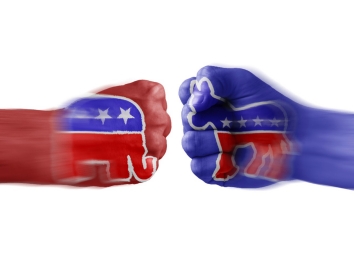When are members of opposing political parties not simply stupid, uninformed, inhuman hordes lacking in ethics and compassion, or incompetent?
When they are in charge. Then they can be creators of a vast conspiracy whose manipulative efforts are everywhere.
How can someone be both mindless and a threat? In the world of social psychology, where weak observational studies rule the land.
"It's hardly surprising that we dehumanize those who are not part of our groups," says co-author Jay Van Bavel, an assistant professor in NYU's Department of Psychology and one of the study's co-authors. "However, what is interesting is that we may be motivated to perceive the presence of a mind among political adversaries who threaten us. It's possible that when we believe our political opponents are formidable we may humanize them in ways we don't with members of other out-groups."

The political opposition is a band of uncivilized, mindless beasts - unless they elect a president, and then they are controlling a brilliant, vast conspiracy. ©iStockPhoto.com/Aquir
In a set of experiments with college undergraduates and on-line adult volunteers, participants viewed a series of faces that were morphs between human faces and inanimate faces (e.g. dolls, statues). An example of this morphing process similar to the one used in these experiments:
Participants were asked to rate how much each entity was "alive" or "had a mind" (1 [definitely has no mind/definitely not alive] to 7 [definitely has a mind/definitely alive]). To clarify the concept of "alive," participants were given the example: a snake is alive while a rock is not. To clarify the concept of "mind," participants were given the example of a human mind differing from that of an animal or robot.
In one experiment, these morphed faces were described as based on either "in-group" members or "out-group" members. In this procedure, which displayed the faces on a computer screen, subjects viewed still images of the morphed faces in random order and rated, from 1 to 7, whether each face was less (no mind/not alive) or more (mind/alive) human.
Their results showed that subjects were more likely to view "in-group" faces as having a mind than they were those faces labeled as members of an "out-group." Specifically, the "out-group" faces needed to morph into a more human form than did "in-group" faces" before they were judged by subjects as having a mind.
In a second experiment, the researchers employed real-world "in-group" and "out-group" examples. Specifically, in this procedure, the researchers labeled the human faces as either NYU students or students from Boston University (BU). University affiliation of faces was cued by an instruction screen—appearing before each facial image—that featured the university name and logo.
The researchers predicted that participants who strongly identified with NYU would be most likely to show an in-group bias. To gauge this, the NYU students responded to a series of statements (strongly agree to strongly disagree), which measured the extent to which they felt invested in, and defined themselves as members of, the NYU community.
The results showed that participants who identified more highly with NYU had higher thresholds for perceiving minds in the BU students than did those who identified less strongly with the New York institution. In other words, for subjects who identified strongly with NYU, the "out-group" (BU) faces needed to morph into a more human form than did "in-group" (NYU) faces before they were judged by these participants as having a mind.
In a final experiment, conducted online, the researchers tested the views of national sample of self-identified Democrats and Republicans in May 2012, after both parties' presidential nominees had become clear and the general election was heating up. Participants were told that they would rate images based on the faces of models from the NYU Democrats and NYU Republicans.
Participants rated the same sets of morph images from the previous studies. Before each set of images, participants saw a cue thanking members of the NYU Democrats or NYU Republicans for serving as models for the upcoming face images and featuring the logo of the political party specified. After completing their ratings, participants reported their own political party affiliation. Finally, participants were asked, "To what extent do you think Democrats (Republicans) pose a threat to Republicans (Democrats)", using a 7-point scale (1 = not at all to 7 = very much).
A portion of these results was consistent with the previous two experiments: Democrats who strongly identified with their group had a higher threshold for judging Republicans as having a mind than they did Democrats and vice versa. However, both Republicans and Democrats who viewed the out-group as threatening more readily viewed their political adversaries as having "a mind" than did those who saw no such threat.
"We often have different perceptions of the minds and mental states of in-group and out-group members," says Leor Hackel, an NYU doctoral student and the paper's lead author. "However, as our findings show, these views may be altered when we take into account concerns such as perceived threat, which may increase the importance of getting inside the out-group mind. We hope these findings can offer insights into better understanding, and perhaps improving, relations between adversarial groups."




Comments